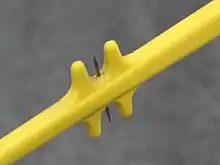Static discharger
Static dischargers, commonly known as static wicks or static discharge wicks, are installed on the trailing edges of aircraft, including (electrically grounded) ailerons, elevators, rudder, wing, horizontal and vertical stabilizer tips. Fitted on almost all civilian aircraft today, they are high electrical resistance (6-200 megaohm) devices with a lower corona voltage than the surrounding aircraft structure. They control the corona discharge into the atmosphere.[1] They are used on aircraft to allow the continuous satisfactory operation of onboard navigation and radio communication systems during precipitation (p-static) conditions. Precipitation static is an electrical charge on an airplane caused by flying through rain, snow, ice, or dust particles. When the aircraft charge is great enough, it discharges into the surrounding air. Without static dischargers, the charge discharges in large batches through pointed aircraft extremities, such as antennas, wing tips, vertical and horizontal stabilizers, and other protrusions. The discharge creates a broad-band radio frequency noise from DC to 1000 MHz, which can affect aircraft communication. Static dischargers contain sharper points than any other part of the aircraft, causing the charge to discharge through them instead, and do so gradually.

Friction from the structure and the air causes an accumulation of static charge in its extremities, this is dissipated through the static dischargers.
Static dischargers are not lightning arrestors and do not affect the likelihood of an aircraft being struck by lightning.
Static dischargers will not function if they are not properly bonded to the aircraft. There must be a conductive path from all parts of the airplane to the dischargers, otherwise they will be useless. Access panels, doors, cowls, navigation lights, antenna mounting hardware, control surfaces, etc., can create static noise if they cannot discharge through the static wick.
The first static dischargers were developed by a joint Army-Navy team led by Dr. Ross Gunn of the Naval Research Laboratory and fitted onto military aircraft during World War II. They were shown to be effective even in extreme weather conditions in 1946 by a United States Army Air Corps team led by Capt. Ernest Lynn Cleveland.
See also
References
- Pia Bergqvist (March 11, 2013). "Check Your Wicks". Flying Magazine. Retrieved March 13, 2017.

